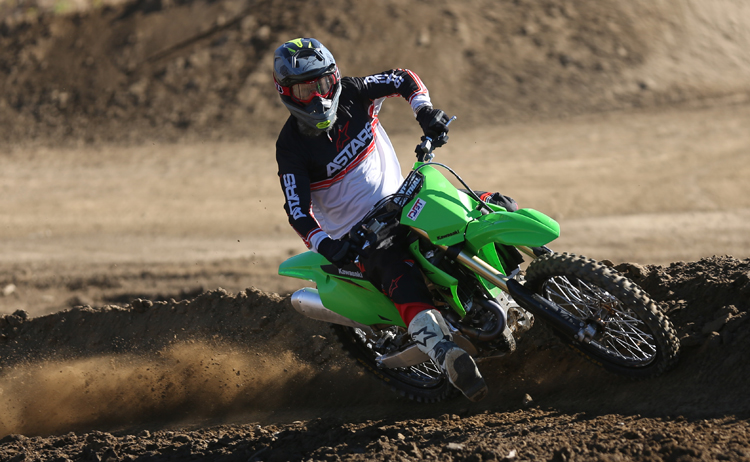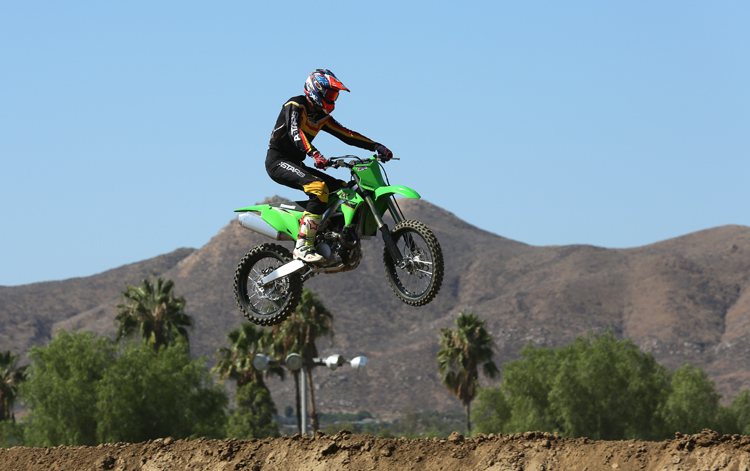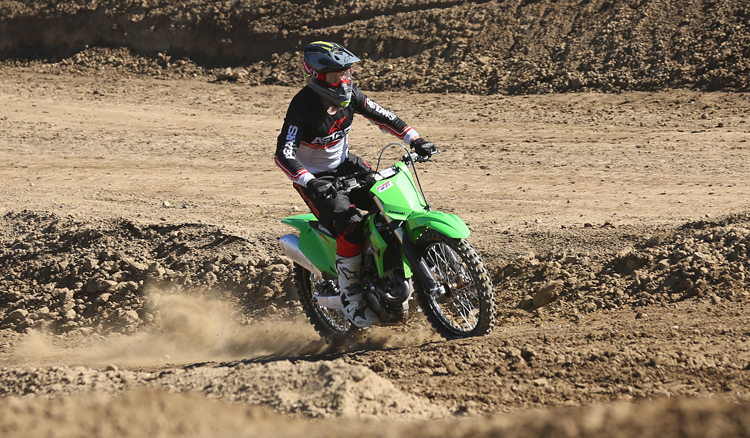Is the 2022 Kawasaki KX450 still one of the best?
Photos: Scott Hoffman
Regardless of other brand’s gadgets and electronics, the Kawasaki KX450 is still a player after four years with only slight updates. Why fix what’s not broken? Yes, we know the KX can be made even better and maybe that is why it’s still such a popular choice. The base or core of the KX450 appeals to such a wide variety of talent. It might not be the lightest or fastest—it just works and feels very good on the track. But now you have to make a choice. Start with a stock KX450 and make it your own? Or, Kawasaki is now offering the 450 SR, which has a lot of the aftermarket goodies, KYB suspension, and updated factory tuning, which also come at a hefty extra price, but that is if you can even get your hands on one, only 400 were made.
The KX450 did receive a few nice updates in 2021 including a complete new larger single-spring clutch, a coated piston for durability, and 1 1/8 handlebar and bar mounts. From there, the rest of the KX is pretty much identical to the KX that was released in 2019, except for MX33 Dunlop tires.
This generation KX450 has also shown its staying power and longevity. Yes, some complain about chain rollers and chain guides wearing out too fast but those are normal wear items and not much of an issue for the average racer or track rider that rides 2-3 times per month. One of our test riders spent several seasons and logged in 80-plus hours on their 2019 KX450 with no issues. Yes, they had to service the suspension, grease up the pivot joints, stay diligent with regard to oil/filter changes, yet other than normal wear items like tires, chains/sprockets, grips, air-filter service, and a few broke levers, the bike never faltered. Even the stock clutch in the ’19 was never serviced after the judder spring and plate were replaced with a standard plate. The valves were never out of spec and the piston was never changed. Your results might differ if you are a thrasher but the durability of the KX is there.
So, what makes the KX so appealing? The KX450 is just easy to ride, with a comfortable/stable chassis, and is confidence inspiring. It’s the entire package versus just one individual component that stands out. There are other models that might do certain tasks better, but they might fall short in other areas. “This bike has the best turning but the chassis is stiff,” for example.
Engine:
The engine offers a good balance of power and tractability. The delivery is not arm-jerking but still fast with a really meaty mid-range. It does rev but the curve goes a little flat way up top, but you can go there if needed. The three adjustable couplers do alter the power from mellow or more aggressive. The standard coupler has been the most popular. The engine is very user-friendly in a good way but not slow either. The delivery does not wear you out like some and you are not as afraid to grab a handful when you need that extra boost. Compared to the 2019-2020 KX450, we actually think the 2021-2022 runs better and feels more connected to the ground. The differences are slight but noticeable. It must have to do with the piston and larger clutch that alters the delivery so slight.
The power is also very tunable but getting your hands on a Kawasaki tuner will run around $700, although there are a slew of performance shops that can make you custom ECU settings to test with. The KX engine is also very appealing to aftermarket exhaust, even slip-ons. Although some of those can feel faster, the aggressive feel can be harder to ride for some in the long run. We advise keeping the stuffer or spark arrestor in the end cap, they offer more back pressure and a smoother yet more robust delivery. Customizing the ECU also works really well with aftermarket exhaust.
Clutch:
Although we did not have any huge issues with the 2019-2020 clutch, the 2021-2022 is way better. The engagement is rock solid, and it does not mind being slipped a little when needed while exiting corners. The hydraulic clutch has a nice feel and is an improvement over the older coil-spring setup.
Suspension:
The KX450 runs the 49mm Showa fork that are very similar to what is utilized on a few other models. What stands out on the KX is they come standard with DLC coatings. The fork is really good but for faster and heavier riders the standard settings are too soft for many. The action is good, but they can ride a little too low in the stroke and bottom a little too easy. Why Kawasaki has not updated the settings since 2019 is still puzzling. There are simple solutions, maybe that’s why KX lovers still keep coming back. Adding 10cc of oil to the fork helps on day one or simply swapping out one or both of the fork springs to one rate stiffer (5.2 N/mm) really improves the fork and the chassis. Light 450 riders under 175 pounds might like the stock settings. Also don’t be afraid to test fork height from flush to 10mm exposed. Depending on rider preferences, it can make a difference.
The shock works pretty well stock, especially if you dial in the fork. 104mm of race sag is a good place to start but you may find yourself making slight adjustments. Nothing really stands out on the rear but there are no issues as well. It tracks well exiting corners, offers nice bottoming control, and does not step out when hitting square-edge holes. Yes, you might feel some of them, but the chassis keeps moving forward.
Chassis:
This is one of the KX’s most appealing qualities, its overall chassis. It appeals to a wide variety of riders and taller riders really seem to be drawn to the KX. Riders like the stability and confidence the KX offers. Maybe slightly larger or longer feeling but not lethargic by any means. What stands out is not what it does outstanding but what it does not do. The KX does not really have any bad traits like feeling too stiff, deflecting, overly twitchy, unstable, too small, or lazy. The seat is comfortable and not too firm or hard, and the rider triangle is very user-friendly. If you are outside of the norm, the chassis is very adjustable via the footpeg height and the handlebar is 4-way adjustable.
Yes, there are some things we wish the KX would do slightly better, but if there were tradeoffs to the overall feel of the bike, it would not be worth it. Turning and tracking in ruts is way better than the pre-2019 chassis but maybe still not as good compared to a few in the field. But again, if overall feel was compromised for slight turning improvements, it would not be working it in our opinion. Overall, it does everything god and that feel is what makes the KX so appealing to some.
What Would We Change?
Since we have not had a chance to ride the SR when we wrote this piece, we are not sure what areas Kawasaki addressed. Here is some rider feedback with regard to the standard KX450:
-Front brake lever is too thin for some riders
-Fork spring is too soft in stock trim
-Multiple map switch would be a nice addition
-Stock chain and sprockets wear a little too fast
-Spoke nipples can deform or round off when adjusting over time
-Front lower steering head bearing can pit and get notchy if not greased often
-Keep an eye on the subframe muffler mount, we have seen a few crack or break, especially if an aftermarket exhaust is not rubber mounted
Overall:
Some speculated Kawasaki would offer a new KX for 2022. In a sense I guess you can call the SR a new bike, yet the heart of the SR is still a 2022 KX450. In today’s world, all of the offered 450 motocross bikes are really good. It’s really what you as a rider are looking for. The KX is still one of the best base platforms for a 450 motocrosser. Maybe not the best 450 in totally stock trim but it can be for some with very little work. Today the new trend is “Special Edition Models.” It almost seems like the new normal. It just depends on if you want to buy an updated model or build one specifically for yourself. The KX450 is solid ride stock and a perfect base for the masses that make a bike their own. Like we have said in the past, if Kawasaki does update the KX450 in 2023, we hope they only improve what they have versus changing what is already really good.











